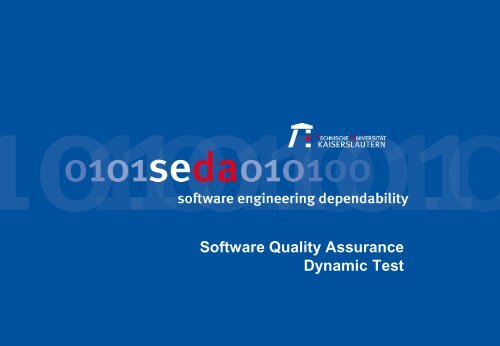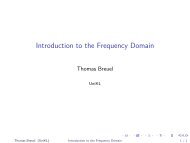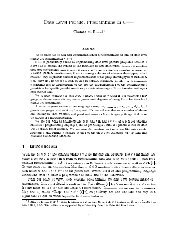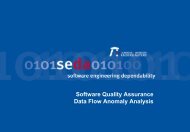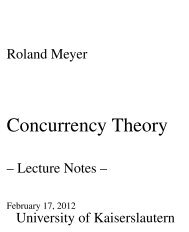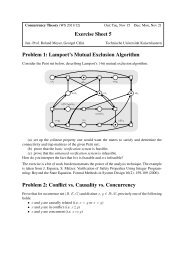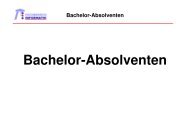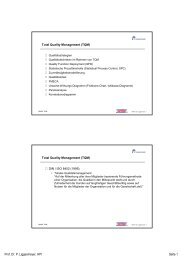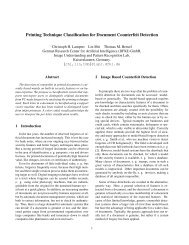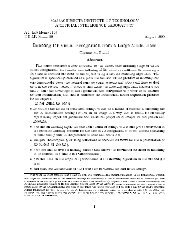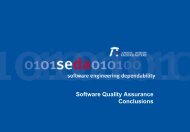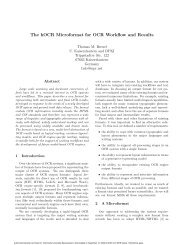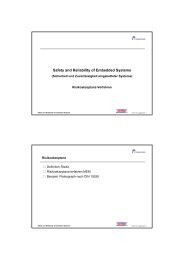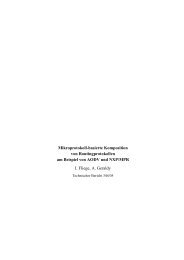Control Flow Testing - Software Engineering: Dependability
Control Flow Testing - Software Engineering: Dependability
Control Flow Testing - Software Engineering: Dependability
Create successful ePaper yourself
Turn your PDF publications into a flip-book with our unique Google optimized e-Paper software.
<strong>Software</strong> Quality AssuranceDynamic Test
Contents• Properties and goals• Structural testing• <strong>Control</strong> flow testing• Data flow testing• Functional test• Diversified test2<strong>Software</strong> Quality Assurance – Dynamic Test© Prof. Dr. Liggesmeyer
Properties and Goals• Properties of dynamic testing• Executable program is provided with concrete input values and is executed• Program may be tested in the real environment• Never complete• Correctness of the tested program cannot be proven• Characteristics of the application of dynamic test methods in practice• Widely-used• Often very unsystematically applied• Tests often not reproducible• Diffuse activity (Management problems)3<strong>Software</strong> Quality Assurance – Dynamic Test© Prof. Dr. Liggesmeyer
Structural <strong>Testing</strong>• Evaluation of the adequacy and completeness of the test cases on the basis ofthe software structure. Determination of the correctness of the outputs based onthe specification• Benefit: Code structure is considered (instructions, branches, data accesses, etc.)• Disadvantage: Forgotten (not implemented), but specified functions cannot be detected• Two approaches• <strong>Control</strong> flow testing• Data flow testing5<strong>Software</strong> Quality Assurance – Dynamic Test© Prof. Dr. Liggesmeyer
<strong>Software</strong> Quality Assurance – Dynamic Test© Prof. Dr. LiggesmeyerStructural <strong>Testing</strong>test casesn startspecificationn 1completenessn 2n 3image of thespecificationn 4evaluateoutputsn 5testern final6
<strong>Control</strong> <strong>Flow</strong> <strong>Testing</strong>• Statement coverage test• Branch coverage test• Condition coverage test• simple• minimal multiple• multiple• LCSAJ-based test• Boundary interior-path test• Structured path test• Path test<strong>Control</strong> flow testing is based on the control structure respectively on the controlflow. The basis is the control flow graph.7<strong>Software</strong> Quality Assurance – Dynamic Test© Prof. Dr. Liggesmeyer
<strong>Software</strong> Quality Assurance – Dynamic Test© Prof. Dr. Liggesmeyer<strong>Control</strong> <strong>Flow</strong> <strong>Testing</strong>Examplevoid CountChars(int &VowelNumber, int &TotalNumber)// Precondition: VowelNumber >ch;while ((ch >= 'A')&&(ch >ch;} //end while}8
<strong>Control</strong> <strong>Flow</strong> <strong>Testing</strong>: <strong>Control</strong> <strong>Flow</strong> Diagramfor the Operation CountChars<strong>Software</strong> Quality Assurance – Dynamic Test© Prof. Dr. LiggesmeyerPathbranch, edgeinstruction, nodesn 1n startvoid CountChars ( int & VowelNumber ,int & TotalNumber){char ch;cin >> ch ;n 2n 3n 4while (( ch >=‘A‘) && ( ch > ch}n final}9
<strong>Control</strong> <strong>Flow</strong> <strong>Testing</strong>Statement Coverage<strong>Software</strong> Quality Assurance – Dynamic Test© Prof. Dr. Liggesmeyer• The statement coverage is the simplest control flow test technique. It is alsoreferred to as C 0 -test• The goal of the statement coverage is to execute each statement at least once,i.e., the execution of all nodes of the control flow graph• The statement coverage rate is the relation of the executed instructions to thetotal number of the instructionsCinstructio n• Then all instructions of the module to be tested are executed at least once acomplete statement coverage test is achieved No untested code !?numberofnumberexecutedofinstructionsinstructions10
<strong>Control</strong> <strong>Flow</strong> <strong>Testing</strong>Statement Coverage• Statement coverage test demands the execution of all nodes of the control flowgraph, i.e., the corresponding program paths must contain all nodes of the controlflow graph• Test casecall of CountChars with: totalnumber = 0input chars: ’A’, ’1’path: (n start , n1, n2, n3, n4, n5, n2, n final )• Observation• The test path contains all nodes• but it does not contain all edges of the control flow graph. The edge (n3,n5) is not contained11<strong>Software</strong> Quality Assurance – Dynamic Test© Prof. Dr. Liggesmeyer
<strong>Control</strong> <strong>Flow</strong> <strong>Testing</strong>Statement Coverage<strong>Software</strong> Quality Assurance – Dynamic Test© Prof. Dr. Liggesmeyer• Statement coverage is considered to be a weak criterion. It has a limited practicalimportance• The standard RTCA DO-178B for software applications in aviation demands toapply statement coverage to level-C-software. In case of a software failure such asoftware can cause a major failure condition12
<strong>Control</strong> <strong>Flow</strong> <strong>Testing</strong>Branch Coverage<strong>Software</strong> Quality Assurance – Dynamic Test© Prof. Dr. Liggesmeyer• Branch coverage aims at executing all branches of the program to be tested. Thisrequires the execution of all edges of the control flow graph. It is also referred toas C 1 -test• Branch coverage is a stricter test technique than statement coverage. Statementcoverage is fully contained in branch coverage. Branch coverage subsumesstatement coverage• Branch coverage is generally considered as a minimal criterion in software unittesting• The standard RTCA DO-178B requires branch coverage testing for level-Bsoftware13
<strong>Control</strong> <strong>Flow</strong> <strong>Testing</strong>Branch Coverage<strong>Software</strong> Quality Assurance – Dynamic Test© Prof. Dr. Liggesmeyer• ExampleBranch coverage demands the execution of all edges of the control flow graph.This is achieved if every decision of the unit under test had at least once thelogical value false and true• Test casecall of CountChars with: totalnumber = 0input chars: „A“, „B“, „1“flow path: (n start , n 1 , n 2 , n 3 , n 4 , n 5 , n 2 , n 3 , n 5 , n 2 , n final )• The test path contains all edges. In particular it contains the edge (n 3 ,n 5 ) which isnot necessarily executed by statement coverage. Branch coverage subsumesstatement coverage14
<strong>Control</strong> <strong>Flow</strong> <strong>Testing</strong>Branch Coverage<strong>Software</strong> Quality Assurance – Dynamic Test© Prof. Dr. Liggesmeyer• Question: Is branch coverage adequate for testing of complicated, compositedecisions?• Examples• Simple decision: if (x > 5)...;• The decision (x > 5) can be regarded as sufficiently tested if both logical valuesoccurred within the test. The decision subdivides the possible test data into twoclasses and demands that at least one test date is selected from every class• Complex decision: if (((u == 0) || (x > 5)) && ((y < 6) || (z == 0))) ...• A test of the decision (((u == 0) || (x > 5)) && ((y < 6) || (z == 0))) against bothlogical values cannot be regarded as sufficient, as the structure of the decision isnot considered appropriately• A complete branch coverage test can be achieved e.g. with the following test casesTest case 1: u = 1, x = 4, y = 5, z = 0Test case 2: u = 0, x = 6, y = 5, z = 015
<strong>Control</strong> <strong>Flow</strong> <strong>Testing</strong>Condition Coverage<strong>Software</strong> Quality Assurance – Dynamic Test© Prof. Dr. Liggesmeyer• Assumption: Composite decisions are tested from left to right. The evaluation ofdecisions stops when its logical value is known. This is referred to as incompleteevaluation of decisions• Test case 1 leads to the following situation• Value 1 of the variable u for the first condition of the OR-connection gives the logicalvalue false. Therefore the second condition of the OR-connection defines the logicalvalue of the OR-connection. The choice of the value 4 for the variable x inserted into thesecond condition (x > 5) also gives the logical value false. Thus the connection of thefirst two decisions also has the logical value false. Due to the subsequent ANDconnectionit is already known at this time that the overall decision has the logical valuefalse. This result is independent from the logical values of the 3rd and 4th condition.This test case thus does not test these parts of the decision• In many cases the logical values of some conditions are not tested. Independently ofthe fact if they are tested the logical value false for the first condition in an ANDconnectionmasks the logical values of all further conditions. Such a test case thus is"blind" with regard to faults in the remaining conditions16
<strong>Control</strong> <strong>Flow</strong> <strong>Testing</strong>Condition Coverage• Test case 2 causes the following situation• The choice of the value 0 for the variable u has the effect that the first condition (u == 0)has the logical value true. Due to the OR-connection of the first two conditions it isensured that the result of the first OR-connection is true. The second condition has notto be tested. The testing can be directly continued with the first condition of the secondOR-connection. The value 5 of the variable y causes the logical value true for thecondition (Y < 6). Due to the OR-operator it is ensured at that time that the overall resultwill be true, independently of the logical value of the fourth condition. Thus this test caseis "blind" with regard to the faults in the 2nd and 4th condition• The test cases 1 and 2 cause a complete branch coverage. None of the two testcases tests the fourth partial decision. Then decisions are evaluated from left toright the conditions at the right hand site may remain untested branch coverage is usually inadequate for testing compound decisions17<strong>Software</strong> Quality Assurance – Dynamic Test© Prof. Dr. Liggesmeyer
<strong>Control</strong> <strong>Flow</strong> <strong>Testing</strong>Condition Coverage<strong>Software</strong> Quality Assurance – Dynamic Test© Prof. Dr. Liggesmeyer• The decision (((u ==0) || (x > 5)) &&((y < 6) || (z ==0))) is abbreviated to((A || B) && ((C || D). We assume thatbetween the values of the variablesu, x, y, and z no dependences exist.Then the partial decisions A, B, C,and D can be true (T) or false (F)independently of each other.Concerning a complete evaluation ofdecisions 16 combinations of logicalvalues are possibleA B C D A||B C||D (A||B)&&(C||D)1 F F F F F F F2 F F F T F T F3 F F T F F T F4 F F T T F T F5 F T F F T F F6 F T F T T T T7 F T T F T T T8 F T T T T T T9 T F F F T F F10 T F F T T T T11 T F T F T T T12 T F T T T T T13 T T F F T F F14 T T F T T T T15 T T T F T T T16 T T T T T T T18
<strong>Control</strong> <strong>Flow</strong> <strong>Testing</strong>Simple Condition Coverage• The simple condition coverage demands the test of all simple conditionsconcerning true and false• Benefits: simple, low test costs• Disadvantages• Limited performance• In general (concerning the complete evaluation of decisions) it cannot be guaranteed that the simplecondition coverage subsumes the branch coverage19<strong>Software</strong> Quality Assurance – Dynamic Test© Prof. Dr. Liggesmeyer
<strong>Control</strong> <strong>Flow</strong> <strong>Testing</strong>Simple Condition Coverage<strong>Software</strong> Quality Assurance – Dynamic Test© Prof. Dr. Liggesmeyer• A simple condition coverage can beachieved, e.g., with the two testcases 6 and 11. The four simpleconditions A, B, C, D are tested eachagainst true and false• The conditions (A || B) and (C || D)and the decision ((A || B) && (C || D))are true in both cases• These test cases do not achieve acomplete branch coverageA B C D A||B C||D (A||B)&&(C||D)1 F F F F2 F F F T3 F F T F4 F F T T5 F T F F6 F T F T T T T7 F T T F8 F T T T9 T F F F10 T F F T11 T F T F T T T12 T F T T13 T T F F14 T T F T15 T T T F16 T T T T20
<strong>Control</strong> <strong>Flow</strong> <strong>Testing</strong>Simple Condition Coverage<strong>Software</strong> Quality Assurance – Dynamic Test© Prof. Dr. Liggesmeyer• If the test cases 1 and 16 werechosen a complete branch coveragewould have been achieved• As the example shows there are testcases which fulfill the simplecondition coverage without ensuringa branch coverage• The simple condition coverage doesnot ensure the branch coverageA B C D A||B C||D (A||B)&&(C||D)1 F F F F F F F2 F F F T3 F F T F4 F F T T5 F T F F6 F T F T7 F T T F8 F T T T9 T F F F10 T F F T11 T F T F12 T F T T13 T T F F14 T T F T15 T T T F16 T T T T T T T21
<strong>Control</strong> <strong>Flow</strong> <strong>Testing</strong>Simple Condition Coverage<strong>Software</strong> Quality Assurance – Dynamic Test© Prof. Dr. Liggesmeyer• If decisions are evaluatedincomplete from left to rightonly 7 combination of truthvaluesexist (instead of 16)• The test cases 6 and 11 whichproduce a simple conditioncoverage if decisions areevaluated completely aremapped to test cases III andVII• In contrast to the incompleteevaluation of decisions the twotest cases cause no completesimple condition coverageTest cases A B C D A||B C||D (A||B)&&(C||D)I 1, 2, 3, 4 F F - - F - FII 5 F T F F T F FIII 6 F T F T T T TIV 7, 8 F T T - T T TV 9, 13 T - F F T F FVI 10, 14 T - F T T T TVII 11, 12, 15, 16 T - T - T T T22
<strong>Control</strong> <strong>Flow</strong> <strong>Testing</strong>Simple Condition Coverage<strong>Software</strong> Quality Assurance – Dynamic Test© Prof. Dr. Liggesmeyer• Partial decision B can be tested againstfalse only by selecting test case I• To test D against false either test case IIor V has to be executed• A simple condition coverage is possible,e.g., with the test cases I, II, III and VII• In addition these test cases ensure acomplete branch coverage• This rule is valid in every situation: Ifdecisions are evaluated incompletelythe simple condition coveragesubsumes branch coverageA B C D A||B C||D (A||B)&&(C||D)I F F - - F - FII F T F F T F FIII F T F T T T TIV F T T - T T TV T - F F T F FVI T - F T T T TVII T - T - T T T23
<strong>Control</strong> <strong>Flow</strong> <strong>Testing</strong>Condition/Decision Coverage• The condition/decision coverage guarantees a complete branch coverage inaddition to a simple condition coverage• It demands that the branch coverage is taken into account explicitly in addition tothe condition coverage• As this is already ensured by the simple condition coverage test concerning anincomplete evaluation of decisions this method is important only for the case ofthe complete evaluation of decisions• Benefits: simple, low test costs, branch coverage is ensured• Disadvantages• Limited performance• Structure of decisions is not really considered24<strong>Software</strong> Quality Assurance – Dynamic Test© Prof. Dr. Liggesmeyer
<strong>Control</strong> <strong>Flow</strong> <strong>Testing</strong>Condition/Decision Coverage<strong>Software</strong> Quality Assurance – Dynamic Test© Prof. Dr. Liggesmeyer• The execution of the test cases 5 and12 results in a completecondition/decision coverage, as thepartial decisions A, B, C, and D andthe overall decision are eachevaluated to true and false• This is possible without testing thecomposite conditions (A || B) and (C|| D) against both logical values• The condition/decision coverage testssimple conditions and decisions• It widely ignores thedecomposition of compounddecisions into conditions onseveral levelsA B C D A||B C||D (A||B)&&(C||D)1 F F F F2 F F F T3 F F T F4 F F T T5 F T F F T F F6 F T F T7 F T T F8 F T T T9 T F F F10 T F F T11 T F T F12 T F T T T T T13 T T F F14 T T F T15 T T T F16 T T T T25
<strong>Control</strong> <strong>Flow</strong> <strong>Testing</strong>Minimal Multiple Condition Coverage<strong>Software</strong> Quality Assurance – Dynamic Test© Prof. Dr. Liggesmeyer• The minimal multiple condition coverage test demands that besides the simpleconditions and the decision also all composite conditions are tested against trueand false• As decisions can be hierarchically structured it is useful to consider this structureduring testing• This condition coverage technique takes into account the structure of decisions ina better way than the methods presented above, as all nesting levels of acompound decision are equally considered26
<strong>Control</strong> <strong>Flow</strong> <strong>Testing</strong>Minimal Multiple Condition Coverage<strong>Software</strong> Quality Assurance – Dynamic Test© Prof. Dr. Liggesmeyer• Concerning a complete evaluation ofdecisions the execution of the test cases 1and 16 results in a complete minimalmultiple condition coverage (all conditionsA, B, C, D, (A || B) and (C || D) and thedecision ((A || B) && (C || D)) are testedagainst both logical values)• Upon closer examination it can berecognized that these two test cases do nottest the logic structure of the decision in areally useful way: If the decision incorrectlywas ((A && B) || (C && D)), none of the twotest cases would have detected this,although all operators would be faulty. Forall conditions and the overall decisionidentical logical values would haveappeared. The test cases are “blind“towards this faultA B C D A||B C||D (A||B)&&(C||D)1 F F F F F F F2 F F F T3 F F T F4 F F T T5 F T F F6 F T F T7 F T T F8 F T T T9 T F F F10 T F F T11 T F T F12 T F T T13 T T F F14 T T F T15 T T T F16 T T T T T T T27
<strong>Control</strong> <strong>Flow</strong> <strong>Testing</strong>Minimal Multiple Condition Coverage• Concerning an incomplete evaluation ofdecisions, e.g., the four test cases I, II,VI, and VII are required• higher test costs• better results• If the decision incorrectly was ((A && B)|| (C && D)), e.g., test case I would haveproceeded differently. The conditions A,C, (A && B) and (C && D) would havebeen evaluated to false. The conditionsB and D would not have beenevaluated. The overall decision is false.The same result is obtained, but in adifferent way. The evaluation of thedecision is broken off at other pointswhich is a chance for the detection offaultsA B C D A||B C||D (A||B)&&(C||D)I F F - - F - FII F T F F T F FIII F T F T T T TIV F T T - T T TV T - F F T F FVI T - F T T T TVII T - T - T T T28<strong>Software</strong> Quality Assurance – Dynamic Test© Prof. Dr. Liggesmeyer
<strong>Control</strong> <strong>Flow</strong> <strong>Testing</strong>Modified condition/decision coverage• The modified condition/decision coverage requires test cases which demonstratethat every condition can influence the logical value of the overall decisionindependently of the other conditions• The application of this method is required by the standard RTCA DO-178 B forflight critical software (level A)• Basically the method aims at a test as extensive as possible with justifiable testcosts• The relation between the number of conditions and the required test cases is linear• For the test of a decision with n conditions at least n+1 test cases are required. The maximumnumber of test cases is 2n29<strong>Software</strong> Quality Assurance – Dynamic Test© Prof. Dr. Liggesmeyer
<strong>Software</strong> Quality Assurance – Dynamic Test© Prof. Dr. Liggesmeyer<strong>Control</strong> <strong>Flow</strong> <strong>Testing</strong>Modified Condition/Decision Coverage• Test of the condition B with the testcases 2 and 6• Show identical logical values for theconditions A, C, and D• Differ in the logical values of thecondition B. In test case 2 condition Bhas the logical value false. In test case6 condition B is true• Differ in the overall result (test case 2gives the overall result false, while intest case 6 the decision has the valuetrue)• Thus it is proven that the simplecondition B can independentlyinfluence the logical value of the overalldecision• A corresponding situation is given forthe test cases 2 and 10 concerning A,9 and 10 concerning D, and 9 and 11concerning CBADCA B C D A||B C||D (A||B)&&(C||D)1 F F F F2 F F F T F T F3 F F T F4 F F T T5 F T F F6 F T F T T T T7 F T T F8 F T T T9 T F F F T F F10 T F F T T T T11 T F T F T T T12 T F T T13 T T F F14 T T F T15 T T T F16 T T T T30
<strong>Control</strong> <strong>Flow</strong> <strong>Testing</strong>Modified Condition/Decision Coverage<strong>Software</strong> Quality Assurance – Dynamic Test© Prof. Dr. Liggesmeyer• Concerning an incomplete evaluation ofdecisions it is necessary to modify therequirement, to retain the logical values of therespectively not tested conditions, while thelogical values of the condition under test andthe overall decision change• Now, for every simple condition the existenceof a test case pair is required whichA• Covers both logical values concerning thiscondition• Covers both logical values concerning the overalldecision• Has identical logical values for all other simpleconditions or was not evaluated at this point• Example: Test cases I and VII are testing thecondition A. They give different logical valuesfor the condition A and the overall decision andconcerning the remaining conditions only havelogical values if these were not evaluated in therespectively other test caseBDCA B C D A || B C ||D (A ||B) && (C || D)I F F - - F - FII F T F F T F FIII F T F T T T TIV F T T - T T TV T - F F T F FVI T - F T T T TVII T - T - T T T31
<strong>Control</strong> <strong>Flow</strong> <strong>Testing</strong>Modified Condition/Decision Coverage<strong>Software</strong> Quality Assurance – Dynamic Test© Prof. Dr. Liggesmeyer• A complete modifiedcondition/decision coverage causesa branch coverage on the objectcode levelfAIVtVIIBtIffCttIIfIIIfDt32
<strong>Control</strong> <strong>Flow</strong> <strong>Testing</strong>Modified Condition/Decision Coverage<strong>Software</strong> Quality Assurance – Dynamic Test© Prof. Dr. Liggesmeyer• But: Not every branch coverage teston the object code level causes acomplete modified condition/decisioncoveragefAtVIIBtIffCttIIfIIIfDt33
<strong>Control</strong> <strong>Flow</strong> <strong>Testing</strong>Multiple Condition Coverage<strong>Software</strong> Quality Assurance – Dynamic Test© Prof. Dr. Liggesmeyer• The multiple condition coverage requiresthe test of all value combinations of theconditions• Benefits• Very extensive test• Subsumes the branch coverage test and all othercondition coverage test techniques• Disadvantages• High test costs (2 n test cases for a decisionwhich is contains n simple conditions)• Sometimes there exists no test data for certaincombinations (e.g., because of incompleteevaluation of decisions or dependences betweenconditions)A B C D A||B C||D (A||B)&&(C||D)1 F F F F F F F2 F F F T F T F3 F F T F F T F4 F F T T F T F5 F T F F T F F6 F T F T T T T7 F T T F T T T8 F T T T T T T9 T F F F T F F10 T F F T T T T11 T F T F T T T12 T F T T T T T13 T T F F T F F14 T T F T T T T15 T T T F T T T16 T T T T T T T34
<strong>Control</strong> <strong>Flow</strong> <strong>Testing</strong>Path Coverage<strong>Software</strong> Quality Assurance – Dynamic Test© Prof. Dr. Liggesmeyer• A program execution causes the execution of a program path which usuallycontains several branches and instructions• Question: How can this be taken into account by a test technique?35
<strong>Control</strong> <strong>Flow</strong> <strong>Testing</strong>Path Coverage• A complete path coverage requires the execution of all different paths of theprogram to be tested• A path p is a sequence of nodes (i, n 1 ,.., n m , j) in the control flow graph with the startnode i and the end node j• Disadvantages• The path coverage test normally is not executable for real programs, as they can havean infinite number of paths. Assuming that the maximum value of an Integer-variable is32767, we get 2 32768 -1 test paths for the operation CountChars. This is roughly 1,41 ·10 9864 paths. The required test time for a test that runs non-stop and executes 1000paths per second would be 4,5 · 10 9853 years. For comparison: The age of the earth isestimated to roughly 4,5 · 10 9 years. Therefore, a complete path coverage test of theoperation CountChars is absolutely impossible• Often a fraction of the paths is not executable• Question: How can the path coverage test be modified so that it is feasible?36<strong>Software</strong> Quality Assurance – Dynamic Test© Prof. Dr. Liggesmeyer
<strong>Control</strong> <strong>Flow</strong> <strong>Testing</strong>: Structured Path Testand Boundary Interior Path Test<strong>Software</strong> Quality Assurance – Dynamic Test© Prof. Dr. Liggesmeyer• The Structured path test distinguishes only paths that execute a loop not morethan k times. This avoids the explosion of the number of paths caused by loops• The structured path test with k=2 is called boundary interior coverage• The boundary interior coverage differentiates the three cases no loop execution,one loop execution and at least two loop executions. This is especially useful dueto the possible interactions between variables before, in and after the loop37
<strong>Control</strong> <strong>Flow</strong> <strong>Testing</strong>Boundary Interior Test<strong>Software</strong> Quality Assurance – Dynamic Test© Prof. Dr. Liggesmeyer• ExampleThe following test cases are necessary for a boundary interior test of theoperation CountChars• 1. Test case for the path outside of the loopThe execution with totalnumber = INT_MAX results in the non-execution of the loop bodytest path: n start , n 1 , n 2 , n final38
<strong>Control</strong> <strong>Flow</strong> <strong>Testing</strong>Boundary Interior Test<strong>Software</strong> Quality Assurance – Dynamic Test© Prof. Dr. Liggesmeyer• 2. Boundary test casesa. The execution with totalnumber = 0 and the input of the character string A1 causes the enteringof the loop body, the execution of the true-branch of the selection, and subsequently thetermination of the looptest path: n start , n 1 , n 2 , n 3 , n 4 , n 5 , n 2 , n finalb. The execution with totalnumber = 0 and the input of the character string B1 causes the enteringof the loop body, the execution of the false-branch of the selection and subsequently thetermination of the looptest path: n start , n 1 , n 2 , n 3 , n 5 ,n 2 , n final39
<strong>Control</strong> <strong>Flow</strong> <strong>Testing</strong>Boundary Interior Test<strong>Software</strong> Quality Assurance – Dynamic Test© Prof. Dr. Liggesmeyer• 3. Interior test casesa. The execution with totalnumber = 0 and the input of the character string EIN1 causes threeexecutions of the loop body. At the first two executions the true-branch of the selection ispassed through. The third loop execution is irrelevant for the testtest path: n start , n 1 , n 2 , n 3 , n 4 , n 5 , n 2 , n 3 , n 4 , n 5 , n 2 , n 3 , n 5 , n 2 , n finalb. The execution with totalnumber = 0 and the input of the character string AH! causes twoexecutions of the loop body. At the first execution the true-branch of the selection is passedthrough. At the second execution the false-branch is passed. The exclamation mark terminatesthe execution of the loop which is allowed for the interior test after the second execution of theloop bodytest path: n start , n 1 , n 2 , n 3 , n 4 ,n 5 , n 2 , n 3 , n 5 , n 2 , n final40
<strong>Control</strong> <strong>Flow</strong> <strong>Testing</strong>Boundary Interior Test<strong>Software</strong> Quality Assurance – Dynamic Test© Prof. Dr. Liggesmeyerc. The execution with totalnumber = 0 and the input of the character string HH! causes twoexecutions of the loop body. At both executions the false-branch of the selection is passedthrough. The exclamation mark terminates the loop executiontest path: n start , n 1 , n 2 , n 3 , n 5 , n 2 , n 3 , n 5 , n 2 , n finald. The execution with totalnumber = 0 and the input of the character string HA! causes twoexecutions of the loop body. At the first execution the false-branch of the selection ispassed through. At the second execution the true-branch of the selection is passedthrough. The exclamation mark terminates the loop executiontest path: n start , n 1 , n 2 , n 3 , n 5 , n 2 , n 3 , n 4 , n 5 , n 2 , n final• The seven test cases are sufficient for the complete test of the loop according tothe boundary interior criterion41
<strong>Control</strong> <strong>Flow</strong> <strong>Testing</strong>: Relations of the<strong>Control</strong> <strong>Flow</strong> Tests (Subsumes Hierarchy)<strong>Software</strong> Quality Assurance – Dynamic Test© Prof. Dr. Liggesmeyerpath coverage testmultiple conditioncoverage testmodified condition/decision coverageteststructuredpath test(k 2)boundaryinterior testLCSAJ testmodifiedboundaryinterior testminimal multiplecondition coveragetestcondition/decisioncoverage testbranch coverage teststatement coverage testsimple conditioncoverage test42
Data <strong>Flow</strong> <strong>Testing</strong>• Data flow testing is based on the data flow. The basis is the control flow graphenhanced by data flow attributes• Accesses to variables are assigned to one of the classes• write: definition (def)• read: computational use (c-use)• read: predicate use (p-use)43<strong>Software</strong> Quality Assurance – Dynamic Test© Prof. Dr. Liggesmeyer
<strong>Software</strong> Quality Assurance – Dynamic Test© Prof. Dr. LiggesmeyerData <strong>Flow</strong> <strong>Testing</strong>: <strong>Control</strong> <strong>Flow</strong> Graphwith Data <strong>Flow</strong> Attributes for CountCharsnStartdef (total number)def (vowel number)def (ch)p-use (ch)p-use (total number)c-use (total number)def (total number)p-use (ch)c-use (vowel number)def (vowel number)def (ch)c-use (vowel number)c-use (total number)n 1 invoid CountChars ( int &vowel number,int &total number){cin >> ch ;while ((ch >= 'A') && (ch > ch}n out44
Data <strong>Flow</strong> <strong>Testing</strong>• Example• The instruction y = x+1; contains a c-use of the variable x, followed by a definition (def) of thevariable y• The instruction IF (x=0) THEN... contains a p-use of the variable x• The all defs-criterion demands• That every definition (all defs) of a variable is used at least once in a computation or a predicate. Theobjective of an assignment to a variable is that this value is used somewhere once again. The testshave to be chosen in such a way that this is tested at least once for every assignment to everyvariable45<strong>Software</strong> Quality Assurance – Dynamic Test© Prof. Dr. Liggesmeyer
Data <strong>Flow</strong> <strong>Testing</strong>• All p-uses-test• The all p-uses-test requires that every p-use that exists w.r.t. each definition is taken into accountduring testing• All c-uses-test• The all c-uses-test requires that every c-use that exists w.r.t. each definition is taken into accountduring testing• All c-uses / some p-uses-test resp. all p-uses / some c-uses-test• If no c-uses resp. p-uses exist for some variable definitions, it is required that at least one p-useresp. c-use is tested• All uses-test• All c-uses-test + All p-uses-test46<strong>Software</strong> Quality Assurance – Dynamic Test© Prof. Dr. Liggesmeyer
<strong>Software</strong> Quality Assurance – Dynamic Test© Prof. Dr. LiggesmeyerData <strong>Flow</strong> <strong>Testing</strong>all-defsdef(x)c-use 1 (x) c-use 2 (x) p-use 1 (x)p-use 2 (x)all-c-usesall-usesall-p-uses47
<strong>Software</strong> Quality Assurance – Dynamic Test© Prof. Dr. LiggesmeyerData <strong>Flow</strong> <strong>Testing</strong>n start• Test path for the all p-uses-testn inn 1n 2n 3def (total number)def (ch)p-use (ch), p-use (total number)def (total number)n 4n 5n 6p-use (ch)def (ch)n 2n 3p-use (ch), p-use (total number)n 4n 5n 6p-use (ch)def (ch)n 2n 3def (total number)n 4n 6p-use (ch)def (ch)n 2n outp-use (ch), p-use (total number)n finalLegend:n in jpredicate-use (p-use)p-use (...) tested predicate-use48
Data <strong>Flow</strong> <strong>Testing</strong>: Relations of the <strong>Control</strong><strong>Flow</strong> Tests (Subsumes Hierarchy)<strong>Software</strong> Quality Assurance – Dynamic Test© Prof. Dr. Liggesmeyerpath coverageall pathsdata contextcoverageclassifiedall du-pathsrequiredk-tuples-testdata contextcoveragesimpleall usesall c-uses/some p-usesall p-uses/Some c-usesall c-uses all defs all p-usesbranchcoverageall edgesstatementcoverageall nodes49
Functional Test (Specification-based Test)• Determination of the adequacy and the completeness of the test cases as well asderivation of the test data and evaluation of the outputs based on the specification• Benefits: Completeness w.r.t. the specification is checked. The test cases are systematically drawnfrom the specification• Disadvantage: Information represented by the code is discarded50<strong>Software</strong> Quality Assurance – Dynamic Test© Prof. Dr. Liggesmeyer
<strong>Software</strong> Quality Assurance – Dynamic Test© Prof. Dr. LiggesmeyerFunctional Test (Specification-based Test)specificationtest casescompletenessimage of thespecificationevaluateoutputstester51
Functional Test (Specification-based Test)Equivalence Partitioning• Identification of equivalence classes based on the specification (Divide &Conquer)• All Values from an equivalence class• Shall cause an identical behavior and• Shall belong to the same specified program function• All specified program functions are tested with values from the equivalence classassigned to them• Equivalence classes are also generated from the outputs52<strong>Software</strong> Quality Assurance – Dynamic Test© Prof. Dr. Liggesmeyer
Functional Test (Specification-based Test)Equivalence Partitioning - Invalid and valid Equivalence Classes• If a value range is specified as the valid input domain for a particular inputvariable, this range represents a valid equivalence class which is enframed byinvalid equivalence classes at its lower and upper boundary• Example• Input range: 1 x 99• One valid equivalence class: 1 x 99• Two invalid equivalence classes• x < 1• x > 9953<strong>Software</strong> Quality Assurance – Dynamic Test© Prof. Dr. Liggesmeyer
Functional Test (Specification-based Test)Equivalence Partitioning - Invalid and valid Equivalence Classes• The equivalence classes are to be numbered. For the generation of test casesfrom the equivalence classes two rules have to be applied• The test cases for valid equivalence classes are generated by the selection of test data from asmany valid equivalence classes as possible• The test cases for invalid equivalence classes are generated by the choice of test data from aninvalid equivalence class. It is combined with values which are extracted exclusively from validequivalence classes• Selection of the concrete test data from an equivalence class according todifferent criteria• Often used: test of the equivalence class boundaries (boundary value analysis)54<strong>Software</strong> Quality Assurance – Dynamic Test© Prof. Dr. Liggesmeyer
Functional Test (Specification-based Test)Equivalence Partitioning• A program for the inventory management of a shop is capable to registerdeliveries of wooden boards• If wooden boards are delivered, the sort of the wood is entered• The program knows the wood sorts Oak, Beech, and Pine• Furthermore, the length is given in centimeters which is always between 100 and 500• As delivered number a value between 1 and 9999 can be given• In addition, the delivery gets an order number• Every order number for wood deliveries begins with the letter W55<strong>Software</strong> Quality Assurance – Dynamic Test© Prof. Dr. Liggesmeyer
Functional Test (Specification-based Test)Equivalence Partitioning<strong>Software</strong> Quality Assurance – Dynamic Test© Prof. Dr. LiggesmeyerEquivalence classesInput Valid Equivalence Class Invalid Equivalence ClassSort 1) Oak2) Beech3) Pine4) All others, e.g. steelLength 5) 100
Functional Test (Specification-based Test)Equivalence Partitioning<strong>Software</strong> Quality Assurance – Dynamic Test© Prof. Dr. LiggesmeyerTest cases according to equivalence partitioning combined with boundaryvalue analysisTest caseTestesEquivalenceClassesSortOakLength 100Number 11,5L,8L,11Order number W11 2 3 42,5U,8UBeech5009999W2r3Pine200100W544Steel200100W5456UOak99100W5467LOak501100W5479UOak2000W54810LOak20010000W54912Oak200100V157
Functional Test (Specification-based Test)Equivalence PartitioningExercise• The class "triangle" contains the lengths of the triangle sides side1, side2 andside3 as integer-attributes. The operation "type ()" determines the type of thetriangle on the basis of these side lengths. The following cases are differentiated• No triangle: data error of the side lengths• Equilateral• Right-angled• Isosceles• Scalene• The type right-angled is output with priority, i.e., if for example a scalene triangleis right-angled, not scalene but right-angled is output58<strong>Software</strong> Quality Assurance – Dynamic Test© Prof. Dr. Liggesmeyer
Functional Test (Specification-based Test)State-based <strong>Testing</strong><strong>Software</strong> Quality Assurance – Dynamic Test© Prof. Dr. Liggesmeyer• Example: section of a specification• Parameters• PORT_A: calling phone• PORT_B: called phone• PORT_A identifies the connection from which a call is to be set up. The actual state of the call setupis globally available. Depending on this a new state arises after the evaluation of the transferredevent. The delivered state is DISCONNECTED, if the call setup was terminated, it is DIALING, if thecall setup is in progress but not completed yet. It is CONNECTED, if the call setup was successfullycompleted. In this case PORT_B delivers the connection of the selected subscriber, otherwise thedata content of PORT_B is undefined. A call setup requires the sequence UNHOOK (DIGIT_N)* andthe digit sequence must represent a valid number. HANG UP always leads to the completetermination of the call. If TIMEOUT occurs, HANG UP brings the software back into the initial state(DISCONNECTED)59
Functional Test (Specification-based Test)State-based <strong>Testing</strong><strong>Software</strong> Quality Assurance – Dynamic Test© Prof. Dr. LiggesmeyerTIMEOUTOCCURREDtimeout/reset dialed numbertimeout/reset dialed numberhang updigit_0, digit_1,..., digit_9/add digit todialed number,validatedialed numberDIALINGhang up/reset dialed numberunhook/reset dialed numberDISCONNECTEDdialed number invaliddialed number valid/establish connectionhang up/reset dialed number,reset connectionINVALID NUMBERCONNECTEDhang up/reset dialed number60
Functional Test (Specification-based Test)State-based <strong>Testing</strong>• The minimal test strategy is to cover each state at least once.• A better solution is to cover each transition at least once, which leads, e.g., to thefollowing test cases• DISCONNECTED, unhook DIALING, hang up DISCONNECTED• DISCONNECTED, unhook DIALING, timeout TIMEOUT OCCURRED, hang up DISCONNECTED• DISCONNECTED, unhook DIALING, Digit 0..9 DIALING, Digit 0..9 DIALING,dialed number valid CONNECTED, hang up DISCONNECTED• DISCONNECTED, unhook DIALING, Digit 0..9 DIALING, Digit 0..9 DIALING,dialed number invalid INVALID NUMBER, timeout TIMEOUT OCCURRED, hangup DISCONNECTED• Furthermore, it is useful to test all events if transitions can be initiated by morethan one events. The result is a hierarchy of test techniquesall states all transitions all events• Important: Do not forget to test the failure treatment!61<strong>Software</strong> Quality Assurance – Dynamic Test© Prof. Dr. Liggesmeyer
Functional Test (Specification-based Test)State-based <strong>Testing</strong><strong>Software</strong> Quality Assurance – Dynamic Test© Prof. Dr. LiggesmeyerEventStateDISCONNECTED DIALING CONNECTED INVALID NUMBERTIMEOUTOCCURREDunhookhang updigit_0DIALINGFAILUREDISCONNECTEDresetdialednumberFAILURE FAILURE FAILURE FAILUREDISCONNECTEDresetdialednumberDIALINGadd digit todialed number,validate dialednumberDISCONNECTEDreset dialednumber, resetconnectionCONNECTEDDISCONNECTEDINVALIDNUMBERresetdialednumberDISCONNECTEDTIMEOUTOCCURREDeventprevious statefollowingstateactiondigit_9timeoutDISCONNECTEDFAILUREDIALINGadd digit todialed number,validate dialednumberCONNECTEDTIMEOUTFAILUREOCCURREDresetdialednumberINVALIDNUMBERTIMEOUTOCCURREDresetdialednumberTIMEOUTOCCURREDTIMEOUTOCCURREDdialed numbervaliddialed numberinvalidFAILUREFAILURECONNECTEDINVALIDNUMBERestablishconnectionFAILUREFAILUREFAILUREFAILUREFAILUREFAILURE62
Functional Test (Specification-based Test)State-based <strong>Testing</strong> – “Failure”-state added<strong>Software</strong> Quality Assurance – Dynamic Test© Prof. Dr. LiggesmeyerTIMEOUTOCCURREDtimeout/reset dialed numbertimeout/reset dialed numberhang upunhook,dialed number valid,dialed number invaliddigit_0, digit_1,..., digit_9/add digit todialed number,validatedialed numberDIALINGhang up/reset dialed numberunhook/reset dialed numberDISCONNECTEDdialed number invaliddialed number valid/establish connectionhang up/reset dialed number,reset connectionINVALIDNUMBERunhook,dialed number valid,dialed number invalid,unhookunhook,timeout,dialed number valid,dialed number invalid,hang up/reset dialed numberCONNECTEDhang up,timeout,dialed number valid,dialed number invalidFAILURE63
<strong>Software</strong> Quality Assurance – Dynamic Test© Prof. Dr. LiggesmeyerEvaluation of State-based <strong>Testing</strong>+ State-based tests can be used in unit and system testing.+ It has widespread use particularly in technical applications such as industryautomation, avionics, or the automotive industry.- In state charts of large systems, there tends to be an explosion in the number ofstates, which leads to a considerable increase in transitions.64
Other Function-oriented Test TechniquesTransaction <strong>Flow</strong> <strong>Testing</strong>• According to /Beizer 90/ a transaction is a processing module from the view of asystem user. Transactions consist of a sequence of processing steps.• Representation forms for the notation of transaction flow:• <strong>Flow</strong> diagram /Beizer 90/• Sequence diagrams (Message Sequence Chart (MSC) in the object oriented method UML)+ A good basis for generating test cases. It directly specifies possible testcases.- Sequence diagrams display only one out of many different options.65<strong>Software</strong> Quality Assurance – Dynamic Test© Prof. Dr. Liggesmeyer
<strong>Software</strong> Quality Assurance – Dynamic Test© Prof. Dr. LiggesmeyerOther Function-oriented Test TechniquesTransaction <strong>Flow</strong> <strong>Testing</strong> - A message sequence diagram66
<strong>Software</strong> Quality Assurance – Dynamic Test© Prof. Dr. LiggesmeyerOther Function-oriented Test TechniquesTest on the Basis of Decision Tables or Decision Trees• Decision tables or decision trees can be used as a basis for function-orientedtests.+ They guarantee a certain test-completeness by way of their methodical approach.- The size of this representation increases exponentially with the number ofconditions.67
Test on the Basis of Decision Tables orDecision Trees: Example<strong>Software</strong> Quality Assurance – Dynamic Test© Prof. Dr. Liggesmeyer• The following application specifies whether an e-commerce enterprise settlesorders per invoice. Whether the payment of a invoice is possible is determined byif the customer is a new customer, if the order amount is greater than 1000€ and ifhe is a private customer. The three conditions result in eight combinations.68
Test on the Basis of Decision Tables orDecision Trees: Example – Decision table<strong>Software</strong> Quality Assurance – Dynamic Test© Prof. Dr. LiggesmeyerConditionsCustomer = NewCustomerN N N N Y Y Y YOrder Value > 1000 € N N Y Y N N Y YCustomer Type =PrivateCustomerN Y N Y N Y N YActioninvoice payment ispossibleY Y Y Y Y Y Y N69
<strong>Software</strong> Quality Assurance – Dynamic Test© Prof. Dr. LiggesmeyerTest on the Basis of Decision Tables or Decision Trees:Example – Optimized decision tableConditions Customer = New Customer N - - YOrder Value > 1000 € - - N YCustomer Type = Private Customer - N - YAction invoice payment is possible Y Y Y N70
Test on the Basis of Decision Tables orDecision Trees: Example – Decision tree<strong>Software</strong> Quality Assurance – Dynamic Test© Prof. Dr. LiggesmeyerCustomer =New CustomerNYinvoice ispossibleOrderValue> 1000€NYinvoice ispossibleCustomerType =PrivateCustomerinvoice ispossibleNYinvoice is notpossibleEvery path from the root to a leaf of the tree corresponds to a test case.Therefore, there would be four test cases. 71
<strong>Software</strong> Quality Assurance – Dynamic Test© Prof. Dr. LiggesmeyerDiversified Test• Test of several software versions against each other• Back to Back Test• Implementation of 2, 3, or even more versions by independent programmers based onthe same specifications• Evaluation of the outputs by automated comparison• Benefit: test execution (incl. checking of outputs) can be done automatically (saves timeand money)• Disadvantages: Multiple implementation is required. Faults occurring in all versions arenot detected• Mutations Test• In fact no test method but a possibility to evaluate the efficiency (error detection rate) oftest methods. Not explained here• Regression Test• Test of the present version against the previous version in order to identify undesiredchanges of the behavior (e.g. by faults introduced during modification and faultcorrection)72
<strong>Software</strong> Quality Assurance – Dynamic Test© Prof. Dr. LiggesmeyerDiversified Test: Back to Back Testspecificationimage of thespecificationimage of thespecificationProgrammerProgrammertest casesevaluateoutputs≠73
<strong>Software</strong> Quality Assurance – Dynamic Test© Prof. Dr. LiggesmeyerDiversified Test : Back to Back Test• The Back to Back Test requires themultiple realization of softwaremodules based on identicalspecifications• The Back to Back Test iseconomically applicable, ifoutstanding safety and/or reliabilityrequirements exist or an automaticevaluation of the outputs is desiredor required• Common faults remainundetectedFaults inversion 1Faults inversion 2Common faults inall versions(will not be detected)Faults inversion 374
Some additional Dynamic Test“Techniques”• Boundary value analysis• The boundary value analysis selects test data from boundaries• Special values testing / Error guessing• Special values testing selects test cases based on the expertise of experienced testers notacceptable as a single technique, but maybe ok in combination this other techniques, e.g.equivalence partitioning• Stochastic test, also random test• Random test selects test data that fulfills certain statistical requirements. It is not identical with the adhoc-procedure of unsystematic testing• Random testing is usually used in combination with statistical techniques, that allow to determineand predict reliability on a quantitative basis. It may also be used as the test data generationtechnique for Back to Back testing75<strong>Software</strong> Quality Assurance – Dynamic Test© Prof. Dr. Liggesmeyer
<strong>Software</strong> Quality Assurance – Dynamic Test© Prof. Dr. LiggesmeyerEvaluation of data from a Stochastic Test76


